 Indians Archive
Indians Archive  Tribe Game Vault: 9/10/77. A Hearty Shrug for Apathy Club Honoree, John Lowenstein
Tribe Game Vault: 9/10/77. A Hearty Shrug for Apathy Club Honoree, John Lowenstein
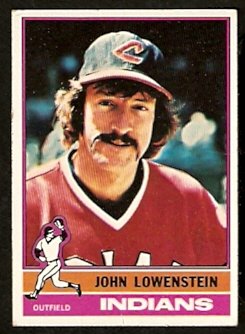 Occasionally, one hears the lament: where have all the great old baseball nicknames gone? History is dotted with the legends of “The Splendid Splinter”, “The Yankee Clipper”, and “The Big Train”; of Cleveland’s “Mudcat”, “Rapid Robert”, and “The Human Rain Delay”.
Occasionally, one hears the lament: where have all the great old baseball nicknames gone? History is dotted with the legends of “The Splendid Splinter”, “The Yankee Clipper”, and “The Big Train”; of Cleveland’s “Mudcat”, “Rapid Robert”, and “The Human Rain Delay”.
Perhaps what isn’t acknowledged is that besides some great nicknames existing in baseball today, lame nicknames have been around forever. It’s like listening to a (good) classic rock station. You might hear such great tunes as “Stay With Me”, “Achilles’ Last Stand”, and “Can’t You Hear Me Knocking” – but at the time those songs were first released, the airwaves were also full of “Feelings”, “Having My Baby”, and “Copa Cabana” . Listening to the distilled, best-of from the 1960s through the 1980s can tend to distort the memory by laundering out “Sometimes When We Touch”. (I know. I take full responsibility for that thing burning a loop into your brain for the rest of the day. “I wanna hold ya, til the fear in me-subsiiiiiiiiiides!” I’m right there with you, if that brings any solace.)
So yeah, there were plenty of trite, unimaginative baseball nicknames back in the day. While the 1970s Cleveland Indians boasted the occasional “Blue Moon” Odom, they also featured “Hammer” (Jack Brohamer), “Robbie” (Frank Robinson), and “Eck” (Dennis Eckersley- who actually gave baseball such gems as “Oil Can”, for Boston teammate Dennis Ray Boyd).
There also was “Steiner”.
John Lowenstein’s dry, off-center sense of humor caused others to variously chuckle, or scratch their heads. He liked to mess with people. If he were asked for his autograph, he might look at them with a straight face and apologize that he’d left it in the clubhouse. When asked how he stayed loose while playing Designated Hitter, he once explained that he flushed the john in between innings to keep his wrists strong. Once, when he failed to execute a sacrifice bunt, he acknowledged as such but noted that he was a better bunter than a billion Chinese: “Those suckers can’t bunt at all.”
His comments weren’t jokes, per se; he just seemed to enjoy causing people to wonder for a moment whether he was being serious. He’d also accomplish this by issuing statements that were obvious to all: “The secret to keep winning streaks going is to maximize the victories while minimizing the defeats.” 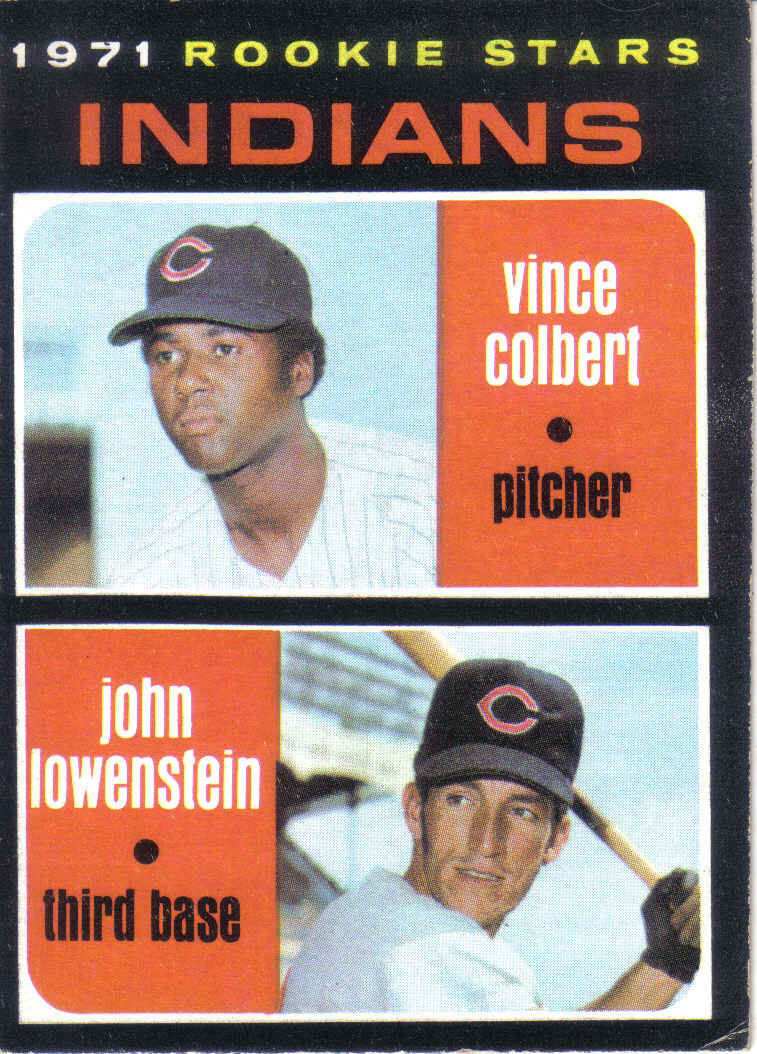 “Nuclear war would render all baseball statistics meaningless.” “If you act like you know what you’re doing, you can do anything you want- except
“Nuclear war would render all baseball statistics meaningless.” “If you act like you know what you’re doing, you can do anything you want- except  neurosurgery.” (There’s actually some solid wisdom in that one.)
neurosurgery.” (There’s actually some solid wisdom in that one.)
Steiner played for the Tribe from 1970 to 1977. For a time, he concurrently held a part time job, shoveling manure at the Cleveland Zoo to supplement his income. When he first reached the majors, he told reporters and announcers his name was pronounced “LowenSTINE”. After they dutifully noted this, and publicly pronounced it as such, he took pains to correct them- it actually was “LowenSTEEN”. The organist at The Stadium began playing “Hava Nagila” to introduce Steiner’s at-bats- apparently, the assumption was that he was Jewish. He commented that he was not; the song was changed to “Jesus Christ, Superstar”. It is not clear whether Lowenstein had anything to do with that, although one may assume he enjoyed the confusion.
In 1974 and 1975, Steiner hit exactly .242 in each season. He declared that he was the most consistent hitter in baseball. After the 1976 season, the Indians exposed DH-1B Rico Carty to the expansion draft, and the Toronto Blue Jays claimed him. Tribe GM Phil Seghi wanted Carty back, so he traded Lowenstein and C Rick Cerone to the Blue Jays for him. Three months later, Seghi again acted on his remorse, trading SS Hector Torres for Lowenstein. So Steiner returned to the Tribe (as an ex-member of a team that had never taken the field) - and hit .242 again, in 1977, to make it three times in four seasons.
Tribe fans may recall the John Lowenstein Apathy Club, from around 1975. (2012 Tribe fans, insert your own joke here.) A fan had approached Lowenstein about forming a fan club. The fan wanted to craft a pro-Lowenstein sign using a white bed sheet, and display it at the Stadium during games. Steiner was opposed to the idea. “Basically, I am against all banners. If somebody puts up a sign about me, I’d immediately disqualify myself from the game. Signs have no ethereal value.”
Of course, the matter did not go away. John, what would be the perfect banner, hung in your honor?
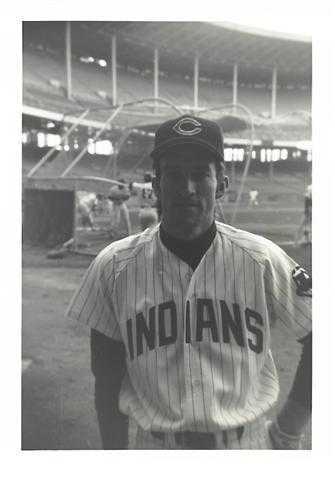 “It would be a huge white sign in the center field bleachers at the Stadium where fans are not allowed to sit. There would be no writing on the banner, and it would be displayed only when the Indians were on the road.”
“It would be a huge white sign in the center field bleachers at the Stadium where fans are not allowed to sit. There would be no writing on the banner, and it would be displayed only when the Indians were on the road.”
Regarding the fan club: “Cheering is bad for a player because it gives him a false sense of importance. Booing indicates a fan really cares enough about him to get mad, which is negative, too. But a fan who really doesn’t care one way or another about him won’t boo or cheer. That is an ideal kind of club member.” The Indians offices began to field hundreds of letters from fans who were interested in joining. Lowenstein had a T-shirt designed showing the back of his head and the word, “APATHY”.
“There is a great solace in not caring. People today are so uptight about everything- war, gasoline, unions- that having complete apathy about something would be welcomed. In a small way, I can bring a moment of peace to my fellow man.” At least once, he gestured to the 70,000ish empty seats at the Stadium and commented on the support of his Apathy Club members.
So against this backdrop of the John Lowenstein experience in Cleveland, it is fun to try and determine the game to pull out of the Vault that best represents the player. On one hand, an 0-fer with a couple strikeouts may seem fitting, but that may have been fairly common. Or perhaps a game in which he did not play. There was the one game in 1971 where Washington Senator and future Tribesman Tom McCraw (a favorite of mine; he always seemed to make solid contact during games I attended) hit a pop fly to shallow left field. SS Jack Heidemann, CF Vada Pinson and LF John Lowenstein converged on the ball and collided. The ball fell harmlessly as McCraw sprinted around the bases for an inside-the-park home run. Each of the three Indians were shaken up enough to need to be removed from the game. (Quick- can you think of who might have been on the bench in 1971, available to enter the game for the Tribe? From the box score: Lou Camilli replaced John Lowenstein (LF) playing SS batting 1st; Chuck Hinton replaced Vada Pinson (CF) playing LF batting 2nd; Ted Ford replaced Jack Heidemann (SS) playing CF batting 8th.)
No, that wasn’t fun. Let’s turn to September 10, 1977. A bad Cleveland Indians team was in Baltimore to face the contending Orioles. Rick Waits vs. Mike 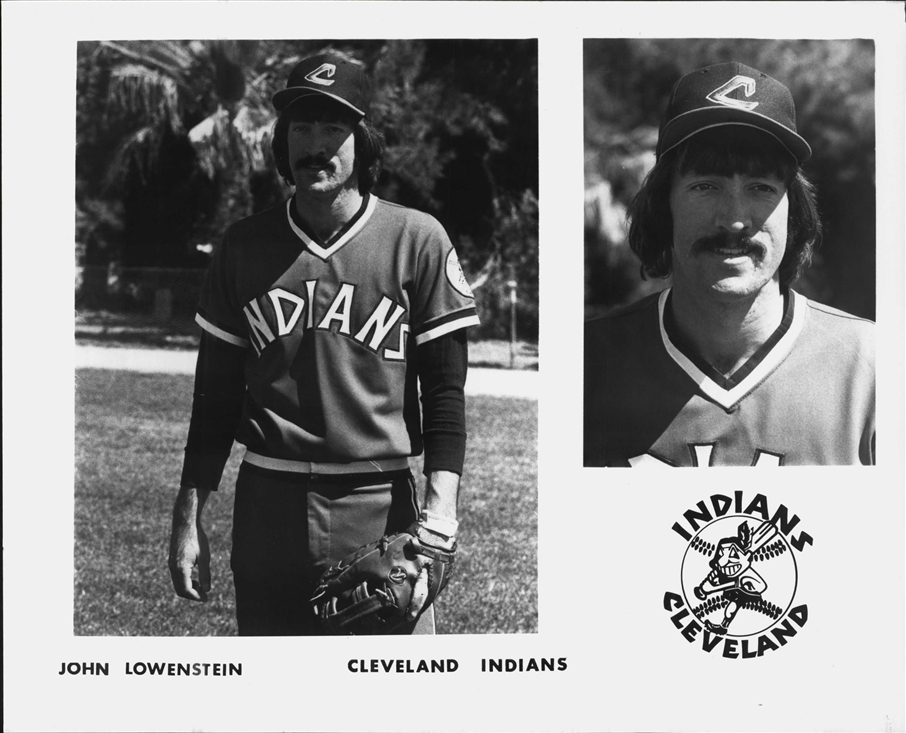 Flanagan; a promising pitching matchup.
Flanagan; a promising pitching matchup.
The offense decided not to join the party until the bottom of the 5th inning, when a ground ball double play off the bat of C Dave Skaggs scored 3B Doug DeCinces. After 5, 1-0 Orioles.
In the top of the 6th, the Indians threatened with two outs, as 2B Duane Kuiper and C Ron Pruitt each singled to left field. But they were stranded. After 6 ½, 1-0 Orioles.
In the bottom of the 7th, the dangerous Baltimore lineup asserted itself against Waits. DH Eddie Murray singled to center, and DeCinces beat out a bunt that was hit back to the pitcher. LF Andres Mora crushed a home run. After 7, 4-0 Orioles.
The Indians went to work in the 9th, against Flanagan. Pruitt led off with a ground ball single to left. 1B Andre Thornton reached on an infield single, and 3B Larvell Blanks singled to center, scoring Pruitt. Orioles manager Earl Weaver removed Flanagan, and brought in reliever Dick Drago to face DH Rico Carty. Carty’s sacrifice fly to right plated Thornton. After Drago walked LF Bruce Bochte, Weaver walked back out to the mound. He summoned Dennis Martinez from the bullpen.
Martinez- “El Presidente”, who one day would anchor the staff of the 1995 American League Champion Cleveland Indians, was in his second season in the majors in 1977. He would start over a dozen games, although Earl Weaver also used his young starters in relief roles as they became established in the big leagues. Seemed to work quite well.
Martinez warmed up, and was ready to go. With two on and one out, Tribe manager Jeff Torborg sent a pinch hitter up to the plate, in place of C Fred Kendall.
It was John Lowenstein.
Steiner delivered. He grounded an opposite-field double down the left field line, scoring Blanks and sending Alfredo Griffin to third (he was running for Bochte). Torborg pinch-hit Jim Norris for SS Frank Duffy, and Norris walked. Bases loaded. CF Paul Dade grounded into a force at second, scoring Griffin- tie game!!! Kuiper then grounded out to third to end the threat. After 8 ½, 4-4 tie.
All those who had pinch-hit and pinch-run for the Indians remained in the game. Lowenstein was in right. Jim Kern came on to get Murray, DeCinces and LF Al Bumbry to go strikeout-groundout-strikeout to send the game to extras. Neither team threatened again until the 11th. With two out, John Lowenstein was up, facing Martinez again.
Lowenstein ripped a home run! 5-4 Tribe, heading to the bottom of the 11th!! The Tribe had been down 4 in the 9th, and now had the lead.
Jim Kern (“Emu”) gave it back in the home half of the inning, and then some. He allowed a single-walk-sac bunt-single-single to make a winner out of Martinez. The run-scoring singles were off the bats of Murray and DeCinces.
So on this day, John Lowenstein rode the bench all the way until the 9th inning. He doubled as the Tribe rallied to tie the game, and then homered for the lead 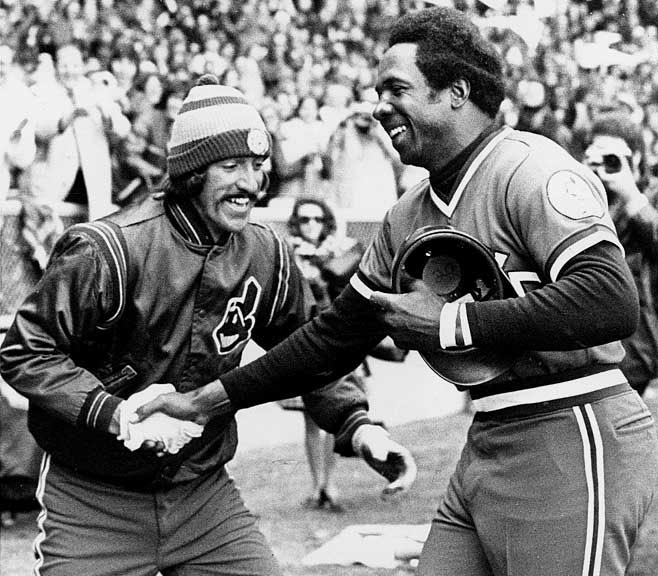 in the 11th. Off a very nice pitching prospect. But it was for naught. While Steiner certainly was disappointed in the outcome, certainly he would appreciate this game being remembered by Tribe fans.
in the 11th. Off a very nice pitching prospect. But it was for naught. While Steiner certainly was disappointed in the outcome, certainly he would appreciate this game being remembered by Tribe fans.
(Photo to right is perhaps the most famous one featuring Lowenstein. In it, he is congratulating Frank Robinson after his first inning home run during his debut as the first black major league manager.)
In 1978, the Indians traded Lowenstein to the Texas Rangers, with Tom Buskey, for OF Willie Horton and P David Clyde. The Rangers would eventually waive him, and Weaver picked him up. The O’s manager was known for using his entire roster, and putting players in the best situations where they could be successful. He began playing Lowenstein in a platoon with Gary Roenicke. Facing right handed pitchers almost exclusively, Steiner’s career had a rebirth- he was a key bat for Baltimore’s playoff teams in the 1980s.
So Baltimore has great memories of Steiner, as well. Good for them- but if he’d ever have been good enough to make the Hall of Fame (he ended up garnering one vote), it says here it would have been with a Cleveland Indians cap.
The back of the cap.
Thank you for reading. Sources included The Cleveland Indians Encyclopedia, Schneider; baseball-reference.com; Wikipedia; Don Cronin, UPI reporter; Baseball Digest; The Baltimore Sun; Blogger Malcolm Allen; Pass the Nuts, Dan Coughlin.
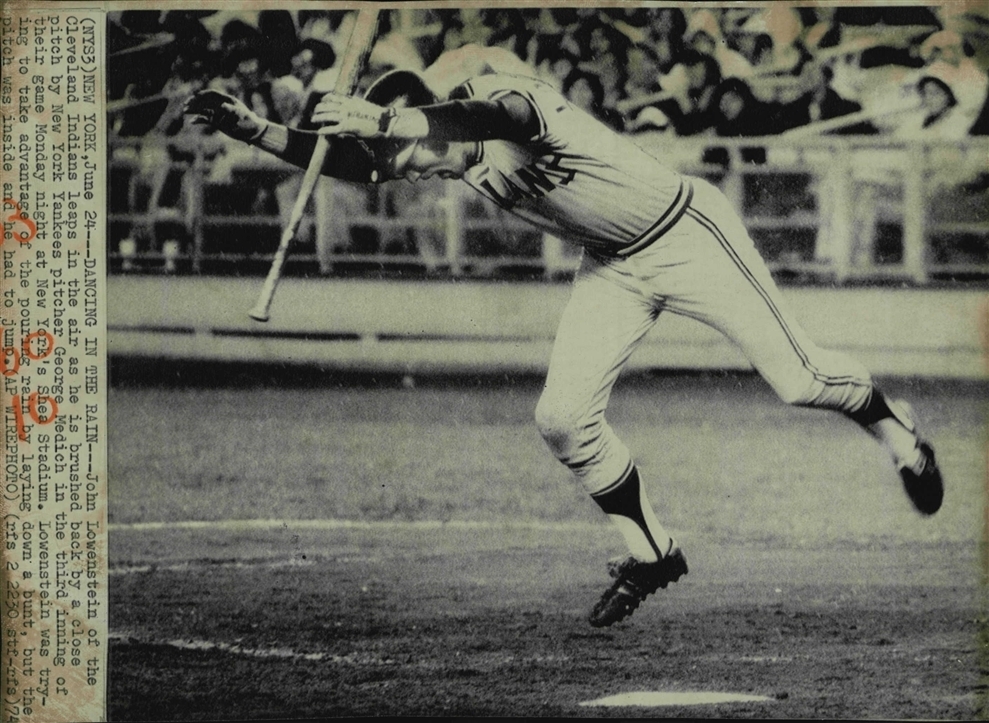
- NBA Announces 2013-2014 Schedule
- Browns Ink Sharknado
- Sharknado A No-Show For Rookie Camp
- Trent Richardson Out Until Training Camp
- Browns Sign Brandon Jackson
- Carrasco Suspended Eight Games
- Browns Add to Wide Receiver Depth with David Nelson
- Browns Need to Learn from Past Draft Mistakes
- Browns Release Chris Gocong and Usama Young
- Browns Missing on Grimes Disappointing, But Not The End
The TCF Forums
- Chris Grant's first 3 drafts
Kingpin74 (Tuesday, January 21 2014 10:13 AM) - The 2014 Offseason Thread
googleeph2 (Tuesday, January 21 2014 9:36 AM) - 2015 Recruiting
furls (Tuesday, January 21 2014 6:57 AM) - Mike Brown
YahooFanChicago (Monday, January 20 2014 11:15 PM) - Movies coming out
HoodooMan (Monday, January 20 2014 9:34 PM) - 2014 Hoops Hockey Hijinx
jpd1224 (Monday, January 20 2014 4:44 PM) - 2014 Recruiting
jclvd_23 (Monday, January 20 2014 2:26 PM) - Wish List - #4 Pick
Hikohadon (Monday, January 20 2014 1:26 PM) - Official- Browns Coach Search/Rumors
OldDawg (Sunday, January 19 2014 6:48 PM) - #1 overall pick Anthony Bennett
TouchEmAllTime (Sunday, January 19 2014 1:28 PM)



